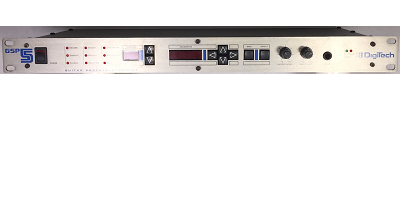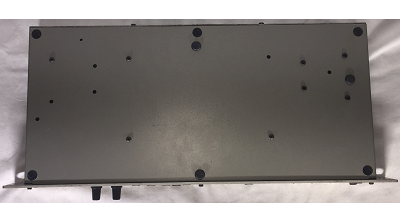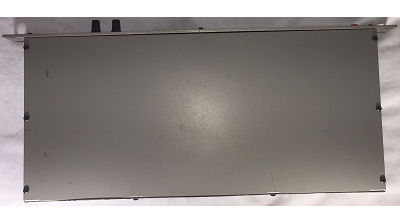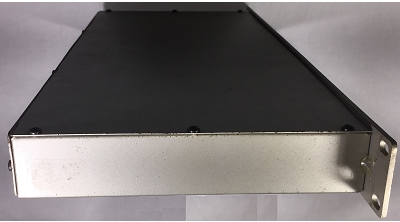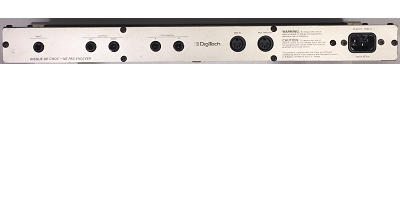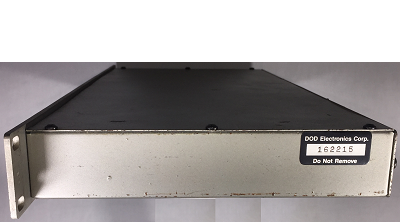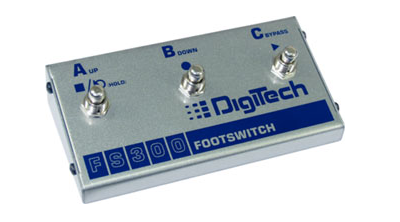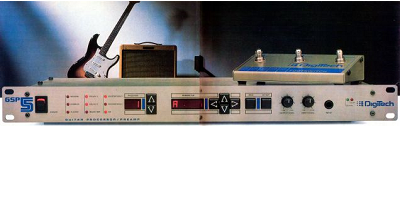Digitech Guitar Processor Runs up to 5 Effects Simultaneously
$220.00

Model# GSP-5
Multi effect rack unit will runs up to 5 effects simultaneously. Effects include: Delay, Echo, Reverb, Flange, Phase Shift, Chorus, Distortion and eq also other special effects. This one space rack unit is great for a guitarist or keyboard player that likes to save custom sounds and use midi to go to them live. 1990, presets era. Fully programmable function save your custom sounds. The foot switch is included
Vintage MIDI Effects Prossor
One of the most attractive aspects of MIDI is that though it was designed to allow keyboards and computers to communicate with each other, it can also be applied to many other forms of music-making. Drummers, wind-instrument players and sound engineers all now use MIDI, and, of course, so do guitarists.
The most familiar application of MIDI for guitarists is in "guitar synths", which use guitar-like controllers such as the Yamaha GS-10 to play synthesiser sounds. But these instruments tend to be expensive, and most guitarists are happy to stick with their conventional electric guitars, and enhance their sounds with effects units.
The DigiTech GSP-5 is a combined pre-amp and programmable effects unit which lets guitarists make the most of MIDI without adventuring into the sometimes baffling world of synths and samplers. Rather than forcing guitarists to rely on a pile of little battery-powered boxes for their effects, the GSP-5 aims to provide a complete "signal-processing" system in one unit. But it also allows the guitarist to "interface" with hi-tech computer and keyboard systems using its MIDI facilities.
Compared to competitive units such as the Korg A-3 and Roland GS-6, the DigiTech GSP-5 is reasonably priced at £549. The UK distributor, John Hornby Skewes, is aiming it at the sort of guitarist who might be willing to pay around the same amount of money for a guitar, such as their latest Charvel (the three-pickup £375 Deluxe) shown in the photos.
Hardware
The GSP-5 is a 1U high 19" rack-mounting unit, but it has little rubber feet so you can also use it in a freestanding mode.
It comes supplied with a three-button footpedal unit which is connected to the back using a cable provided. The three buttons on this box allow you to bypass the effects unit (temporarily disable the effect) or to change program memory up or down. As we'll see, it's also possible to make more creative use of foot control via MIDI. There's a single mono audio input on the back, which is duplicated on the front. However, output can be in stereo. There are two sockets on the back - and many of the preset programs make use of impressive stereo panning effects. MIDI IN and OUT/THRU sockets are also in evidence and rotary Input/Output level knobs and signal/clipping LEDs are on the front.
The GSP-5 has 99 programmable non-volatile effects memories. The current program is displayed on a two-character LED on the left of the front panel, while the LED on the right displays parameters and values which allow you to edit the preset programs as you desire. Each preset can use up to nine different types of effect simultaneously. These include short delay, long delay, distortion, reverb, flanging, EQ and so on. Flipping through the presets with the foot controller or front-panel UP/DOWN buttons, you'll see that the matrix of nine labelled LEDs shows which effects are in use in the current program.
Effects chains
The effects are combined in a selection of thirteen Effects Chains, some of which are simple, such as Reverb/Amp Voicing (simply the selection of Left, Right or Both output channels); while some are more complex, such as Low-Pass Filter/Delay/Reverb/Chorus/Voicing. When creating your own effects, having chosen an Effects Chain, you can then change the parameters of each separate effect. Each parameter is given an abbreviation on the programming LCD; for instance "dL" for Delay Level. Some effects have only a couple of parameters, such as Distortion, which features Level and "Balls" (!). Others have several; Reverb, for instance, has Early Reflection Level, Room Volume, Normalised Reflectivity, Damping, Diffusion, and several more!
The GSP-5 has excellent sixteen-bit sampling quality, and frequency response is 20Hz to 20KHz; the result is a stunning selection of effects, from warm distortion to howling feedback, huge reverb, clean delays, subtle choruses, swooshing flanges, and a range of impressive imitations of popular amplifier sounds. The manual gives the preset effects names such as Arena Sound Check, Dragon Queen and Animal Flange; it's just a pity that unlike units such as the Alesis Quadraverb, the LCD display of the GSP-5 doesn't allow these names to appear on the effects unit.
By the way, although your edited versions of the presets can be stored in the unit, or dumped via system exclusive messages to any MIDI data recorder, you can always restore any or all of the factory presets with a simple control sequence.
Continuous controllers
The GSP-5 can respond to MIDI messages on any selected MIDI channel, or on all channels in OMNI mode. It recognises two types of MIDI information; program change and continuous controllers. Obviously, program change messages, whether sent from a keyboard or a sequencer, will only select a new pre-programmed effect on the GSP-5, from 01 to 99. Continuous controllers are a bit more complicated. The MIDI standard includes 127 "continuous controller" numbers, which allow MIDI units to transmit and receive real-time performance information. Some of these have agreed functions, such as Portamento Time or Tremolo Depth; others are undefined.
On the GSP-5, any effect parameter can be controlled by any continuous controller; in other words, using a sequencer or the required foot-pedal controllers, you can alter functions such as the number of repeats in a delay, the amount of distortion or the setting of a filter, as you play the guitar. The DigiTech PDS-3500 or PDS-1280 MIDI pedals send MIDI program change messages, but for continuous control you'll need the DOD FX-17 Volume/Controller pedal too.
Connecting up and programming the system is a bit complex; the mains-powered FX-17 generates a control voltage of 0-5 volts, and is connected to the PDS-3500, which converts this into MIDI messages which the GSP-5 can understand. To program the PDS-3500 MIDI pedal you first set its channel number, then choose a program number, then a MIDI continuous controller number, and store this as a preset. The PDS-3500 plugs into the MIDI IN of the GSP-5, then you must program the GSP-5 to respond to the MIDI continuous controller information. Press the MIDI button; select the required MIDI channel; then, using the left/right cursors, select the effect parameter you want to control. The up/down buttons are then used to assign a continuous controller to that parameter.
Sound Results
It sounds complicated, but the effort is worth it. The complete set-up allows you to link in your guitar system with a computer or keyboard. You could, for instance, program a sequencer in such a way that it selects the guitar effect, and type of foot-pedal effect control, for each part of a song, or indeed for an entire live performance. Since the alternative has traditionally been a frantic race to stomp the right selection of half-a-dozen pedals in between songs, without pulling out any leads with your foot, it looks as if the GSP-5 proves that MIDI has saved the day again!
Used – Good
Same Day Shipping - Ships from Blonds personal stash
Located in: New Orleans, Louisiana, United States
Handling Cost:
$20.00 will be added on items over 30lb
$50.00 will be added on items over 100lb
Free local pickup
Shipping: Calculate
make an offer
